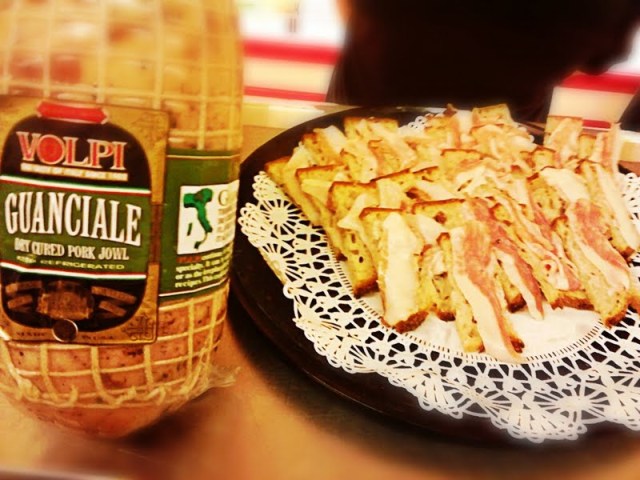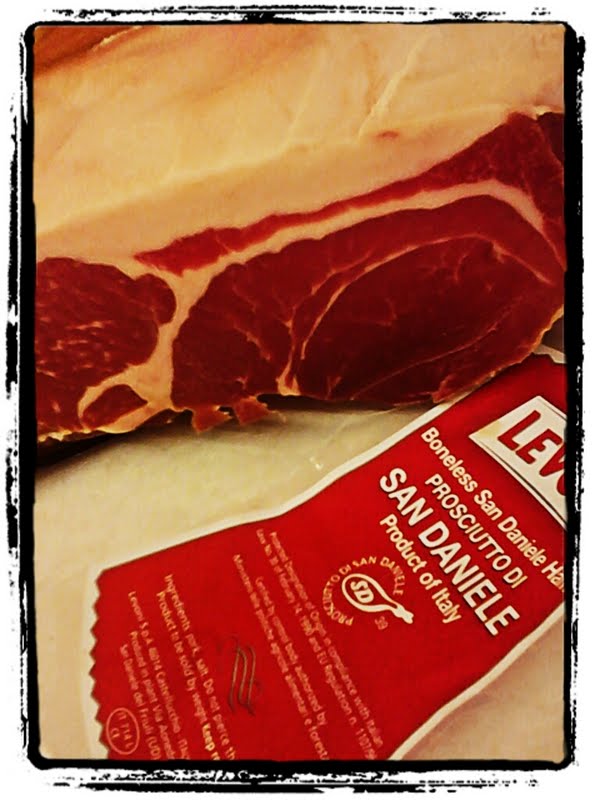Monthly Archives: August 2013
Using salt to preserve meat goes back to the Egyptians, but this is a modern guide to making Guanciale recipes without all this hassle
— The ancient Egyptians were probably the first to use salt to preserve meat and fish.
Somewhere down the line, the Celts developed a specialization in curing and trading hams, and they introduced salt-cured meats to the Romans, who developed a taste for cured meats and sausages which has been passed along into Italia modernity.
Despite technological advances in food production and preservation, cured meats remain with us today. Over the past decade or so, there’s been a curing revival. The preparation of artisanal, “house cured” meats has become popular in professional kitchens.
My cookbook recipe memories raced back to a recipe for Guanciale, (gwan-she-a-lay) is a kind of Italian bacon. –that resembles pancetta and like saffron or truffles, is one of those fundamental ingredients for which there is considered to be no substitute.
My path to creating a recipe for Bucatini alla Amatriciana set me towards an ancient path to my first taste of this eternal food. Guanciale is usually prepared by patting the raw cheek meat of Pork dry and rubbing them with a mixture of thyme, peppercorns, sugar, and kosher salt.
- Salting and the “cure”….explained.
Salt works to preserve meat in two ways: by stopping the activity and reproduction of bacteria and by shutting down the work of enzymes that encourage spoilage. Salt deactivates bacteria through the process of osmosis, whereby water is passed in and out of semi-permeable membranes. When raw meat is exposed to a high concentration of salt, the salt dissolves into the water in the meat, creating a salty solution that exerts pressure on the cell walls, disrupting the equilibrium in which the bacteria cannot survive and feed. The outward pressure prevents the bacteria from drawing in any nutrients, and without nutrients, they are prevented from reproducing. Any spoilage that would normally take place due to bacterial growth is suspended in time. The introduction of salt also upsets the electrical balance of the liquid in which enzymes act, stopping their activity as well.
Using an Italian masterpiece. Guanciale can be bought from Italian markets so you don’t have weeks of the “curing” schedule. It looks like bacon, fry it in a little olive oil until crisp, drained it. The taste is like pancetta or bacon, but perhaps with a stronger flavor of pork and a slight sweetness along with the salinity. It is much fattier than pancetta, but once it is cooked, most of the fat renders out, leaving behind a crispy puff of porkiness.
Three Italian Classics that have to be experienced using the RIGHT product; Guanciale:
Bucatini alla Amatriciana, Spaghetti alla Gricia, and Spaghetti alla Carbonara. Bucatini alla Amatriciana combines bucatini, a long, thin, tube-shaped pasta, with sautéed guanciale, tomatoes, and onions. Hot chili pepper gives the dish a piquancy and the sauce is bound together with sharp Pecorino romano. The fatty and intensely flavored guanciale, caramelizes in the pan to give the simple tomato- and onion-based sauce an extraordinary depth of flavor. Spaghetti alla Gricia, the tomato-less cousin of bucatini all’amatriciana. Also known as un’amatriciana in bianco (white amatriciana), it is made by sautéing guanciale and hot chili pepper, and then tossing the crispy bits with spaghetti and grated Pecorino romano cheese. This pasta highlights guanciale flavors and if you like the idea of bacon and cheese, you’ll like spaghetti alla gricia. Spaghetti alla Carbonara is made with either pancetta or guanciale and it always includes eggs, Pecorino romano, and black pepper. While there is no cream in the dish, you would almost never know. When the eggs and cheese make contact with the pasta, they are transformed into a creamy sauce punctuated by the crisp little pieces of guanciale.
When only the best will do. Levoni Prosciutto
Levoni Proscuitto
http://www.levoni.it/en/prod-144-1973-vacuum_packed_bone_out_san_daniele_ham.aspx
Prosciutto di San Daniele by Principe
The microclimate of Italy’s San Daniele del Friuli is a key and irreplaceable element of prosciutto’s amazing taste.
The cold air coming from the foothills of the Alps clashes against the hot streams of the Adriatic Sea, thus creating climate conditions that are extremely favorable for ageing processes. Only the legs that pass the rigid quality control of Principe (more than 15% are discarded at their arrival in the Company’s factory) are branded and destined to the production of San Daniele Prosciutto. The salting of San Daniele Products follows a procedure called “full salting”: the leg is entirely covered with sea salt and is left for about a week in low-temperature cells. At the end of this stage, hams are “brushed” to eliminate external salt, they are trimmed with a knife and hung for a period of 100-105 days.
At this moment the slow and progressive aging process begins, lasting at least six months. Only the hams that pass the rigid controls will display the indelible brand of San Daniele D.O.P.

